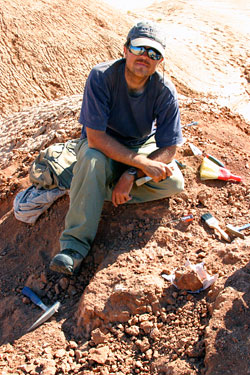![]()
 Gabe S. Bever
Gabe S. Bever
Department of Vertebrate Paleontology
American Museum of Natural History
Central Park West at 79th
New York, New York 10024
USA
As a post-doctoral research fellow in the Division of Paleontology at the American Museum of Natural History, Dr. Gabe Bever has published papers on a wide variety of topics. These include early mammals, carnivoran mammals, rodents, elephants, frogs, turtles, lizards, snakes, sauropod dinosaurs, theropod dinosaurs, as well as theoretical contributions directed at integrating paleontology with other biological disciplines (e.g., evolutionary developmental biology). Gabe’s current research concentrates on evolution within Coelurosauria—a group of theropod dinosaurs that includes such familiar forms as Tyrannosaurus rex, Velociraptor mongoliensis, and birds.
More specifically, Gabe studies how anatomical variation expressed during the course of an organism’s lifetime (ontogeny) is related to broad patterns of evolutionary relationships (phylogeny). To accomplish this, Gabe integrates studies of living reptiles (including birds) with the wonderful collection of dinosaur embryos and post-hatching juveniles that were found and made famous by the international expeditions of the American Museum with collaborating institutions in places like Argentina, China, and Mongolia. One of the tools facilitating Gabe’s research is high-resolution computed tomography (CT), which allows him to observe and model, in a non-destructive way, internal anatomical features that otherwise would be inaccessible in highly delicate and unique fossils. These features include, for example, patterns of cranial circulation and innervation, as well as the shape of the endocranial space—the cavity housing the brain and its associated structures.
Gabe was born in Aurora, Colorado but was raised largely in eastern Kansas. In contrast to many of his colleagues, Gabe did not grow up as a fossil enthusiast but instead spent his time roaming the forests near the Kansas-Missouri border observing the behavior and ecological interactions of living mammals. Gabe did his undergraduate work in biology at Pittsburg State University, a small school in southeastern Kansas. His mentor there was an expert on canid ecology and behavior, which only encouraged Gabe’s scientific predispositions.
Gabe almost entered the University of Alaska at Fairbanks for graduate work studying the behavior of arctic mammals, but in the fall of his senior year he took a course called “Comparative Anatomy of the Vertebrates.” The long hours of dissection—tracing the evolutionary history of anatomical structures across the major groups of vertebrates—totally blew him away. He knew at that point he wanted to become an evolutionary morphologist, but who studies this sort of thing? The course professor encouraged Gabe to think about paleontology for graduate work, which had become a highly interdisciplinary field full of people pursuing the types of questions Gabe seemed to be developing an interest in. Knowing basically nothing about fossils, and certainly never having considered their study as a career path, it was at this point that Gabe went to the library and checked out his first book on paleontology.
Gabe did his doctoral work at The University of Texas at Austin, where he wrote a 700+ page dissertation on the relationship between population-level evolutionary processes (the type Darwin concentrated on) and broad evolutionary patterns of morphological change as interpreted from the vertebrate fossil record. During graduate school, he also began studying Mesozoic reptiles and was involved in field expeditions to collect their fossils in Arizona, New Mexico, Colorado, Kansas, South Dakota, Utah, and Wyoming. After graduation, Gabe accepted a research fellowship at the AMNH working with Dr. Mark Norell and since that time has done fieldwork in the Gobi Desert of both northwest China and Mongolia.